Woods Equipment BH6000 User Manual
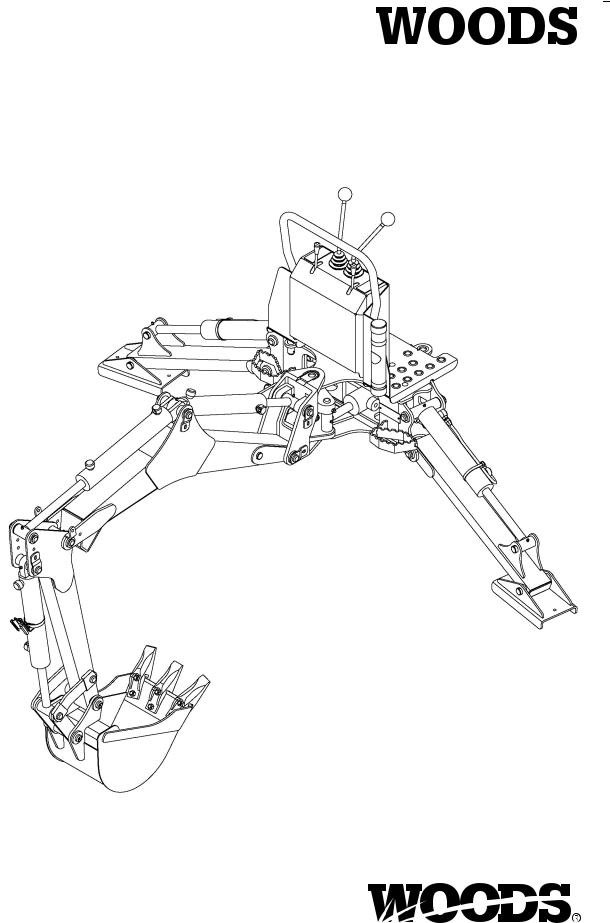
MAN0306 (Rev. 5/23/2008)
BACKHOE
BH6000
Tested. Proven. Unbeatable.

 OPERATOR'S MANUAL
OPERATOR'S MANUAL

TO THE DEALER:
Assembly and proper installation of this product is the responsibility of the Woods® dealer. Read manual instructions and safety rules. Make sure all items on the Dealer’s Pre-Delivery and Delivery Check Lists in the Operator’s Manual are completed before releasing equipment to the owner.
The dealer must complete the Product Registration online at the Woods Dealer Website or complete the mail-in form included with the Operator’s Manual. If using the mail-in form, the dealer is to return the prepaid postage portion to Woods, give one copy to the customer, and retain one copy. Failure to register the product does not diminish customer’s warranty rights.
TO THE OWNER:
Read this manual before operating your Woods equipment. The information presented will prepare you to do a better and safer job. Keep this manual handy for ready reference. Require all operators to read this manual carefully and become acquainted with all adjustment and operating procedures before attempting to operate. Replacement manuals can be obtained from your dealer. To locate your nearest dealer, check the Dealer Locator at www.WoodsEquipment.com, or in the United States and Canada call 1-800-319-6637.
The equipment you have purchased has been carefully engineered and manufactured to provide dependable and satisfactory use. Like all mechanical products, it will require cleaning and upkeep. Lubricate the unit as specified. Observe all safety information in this manual and safety decals on the equipment.
For service, your authorized Woods dealer has trained mechanics, genuine Woods service parts, and the necessary tools and equipment to handle all your needs.
Use only genuine Woods service parts. Substitute parts will void the warranty and may not meet standards required for safe and satisfactory operation. Record the model number and serial number of your equipment in the spaces provided:
Model: _______________________________ |
Date of Purchase: _____________________ |
Serial Number: (see Safety Decal section for location) ____________________________________
Provide this information to your dealer to obtain correct repair parts.
Throughout this manual, the term NOTICE is used to indicate that failure to observe can cause damage to equipment. The terms CAUTION, WARNING, and DANGER are used in conjunction with the Safety-Alert Symbol (a triangle with an exclamation mark) to indicate the degree of hazard for items of personal safety.
|
|
|
|
2 Introduction |
Gen’l (Rev. 2/19/2008) |
||
|
|
|
|
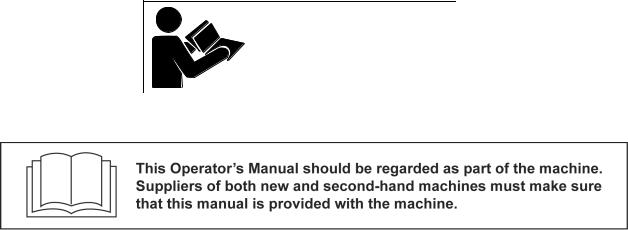
TABLE OF CONTENTS
INTRODUCTION . . . . . . . . . . . . . . . . . . . . . . . . . . . . . . . . . . . . . . . . . . . . . . ii BH6000 SPECIFICATIONS . . . . . . . . . . . . . . . . . . . . . . . . . . . . . . . . . . . 4 - 5 GENERAL INFORMATION . . . . . . . . . . . . . . . . . . . . . . . . . . . . . . . . . . . . . . 6 SAFETY RULES . . . . . . . . . . . . . . . . . . . . . . . . . . . . . . . . . . . . . . . . . . . . . . 7 SAFETY DECALS . . . . . . . . . . . . . . . . . . . . . . . . . . . . . . . . . . . . . . . . . . . . 10 OPERATION . . . . . . . . . . . . . . . . . . . . . . . . . . . . . . . . . . . . . . . . . . . . . . . . 12 OWNER SERVICE . . . . . . . . . . . . . . . . . . . . . . . . . . . . . . . . . . . . . . . . . . . 19 TROUBLE-SHOOTING . . . . . . . . . . . . . . . . . . . . . . . . . . . . . . . . . . . . . . . . 21 DEALER SERVICE . . . . . . . . . . . . . . . . . . . . . . . . . . . . . . . . . . . . . . . . . . . 22 DEALER CHECK LIST . . . . . . . . . . . . . . . . . . . . . . . . . . . . . . . . . . . . . . . . 29 ASSEMBLY . . . . . . . . . . . . . . . . . . . . . . . . . . . . . . . . . . . . . . . . . . . . . . . . . 26 INDEX TO PARTS LISTS . . . . . . . . . . . . . . . . . . . . . . . . . . . . . . . . . . . . . . 31 BOLT TORQUE CHART . . . . . . . . . . . . . . . . . . . . . . . . . . . . . . . . . . . . . . . 41 BOLT SIZE CHART & ABBREVIATIONS . . . . . . . . . . . . . . . . . . . . . . . . . . 42 INDEX . . . . . . . . . . . . . . . . . . . . . . . . . . . . . . . . . . . . . . . . . . . . . . . . . . . . . 43 PRODUCT WARRANTY . . . . . . . . . . . . . . . . . . . . . . . INSIDE BACK COVER REPLACEMENT PARTS WARRANTY . . . . . . . . . . . . . . . . . . .BACK COVER
!LEA EL INSTRUCTIVO!
Si no lee Ingles, pida ayuda a alguien que si lo lea para que le traduzca las medidas de seguridad.
MAN0306 (Rev. 5/23/2008) |
Introduction 3 |
|
|

BH6000 SPECIFICATIONS
|
|
English |
Metric |
||
|
|
|
|
|
|
|
|
|
12" Bucket |
|
12" Bucket |
Description |
Illustration |
8" Bucket |
16" Bucket |
8" Bucket |
16" Bucket |
|
|
|
|
|
|
Transport Height* |
A |
60.0" |
60.0" |
1524 mm |
1524 mm |
Stabilizer Spread (Transport)* |
|
51.0" |
51.0" |
1295 mm |
1295 mm |
Angle of Departure** |
|
15° |
15° |
15° |
15° |
Digging Depth, Maximum* |
F |
75.5" |
74.0" |
1918 mm |
1880 mm |
Digging Depth, 2 ft. Flat bottom* |
G |
74.0" |
72.5" |
1880 mm |
1842 mm |
Digging Depth, 8 ft. Flat bottom* |
H |
47.0" |
44.0" |
1194 mm |
1118 mm |
Overall Operating Height* |
J |
91.0" |
90.0" |
2311 mm |
2286 mm |
Loading Height* |
K |
54.0" |
54.5" |
1372 mm |
1384 mm |
Loading Reach* |
L |
33.5" |
35.5" |
851mm |
902mm |
Reach from Swing Pivot* |
M |
98.0" |
96.3" |
2489 mm |
2446 mm |
Bucket Rotation* |
|
180° |
180° |
180° |
180° |
Swing Arc* |
|
150° |
150° |
150° |
150° |
Stabilizer Spread (Operating)* |
|
77.5" |
77.5" |
1969 mm |
1969 mm |
Leveling Angle* |
|
12° |
12° |
12° |
12° |
Operating Pressure* |
|
1780 psi |
1780 psi |
12.27 MPa |
12.27 MPa |
Operating Flow |
|
3.5 - 5.0 gpm |
3.5 - 5.0 gpm |
13.2 - 18.9 Ipm 13.2 - 18.9 Ipm |
|
Bucket Digging Force* |
|
2025 lbs |
2200 lbs |
9008 N |
9786 N |
Dipperstick Digging Force* |
|
1150 lbs |
1180 lbs |
5115 N |
5249 N |
|
|
|
|
|
|
Bucket Capacity (Heaped) |
|
cu.-ft. |
cu.-meter |
|
|
|
|
8" (203mm) |
|
0.63 |
0.018 |
12" (305mm) |
|
0.90 |
0.025 |
16" (406mm) |
|
1.31 |
0.037 |
|
|
|
|
*Per Definitions in SAE J49 Standard
**Per Definitions in SAE J1234 Standard
4 Introduction |
MAN0306 (Rev. 5/23/2008) |
|
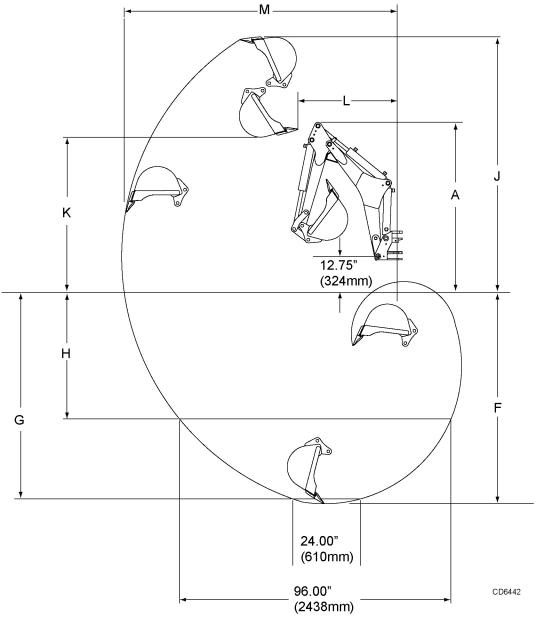
BH6000 SPECIFICATIONS
MAN0306 (Rev. 5/23/2008) |
Introduction 5 |
|
|
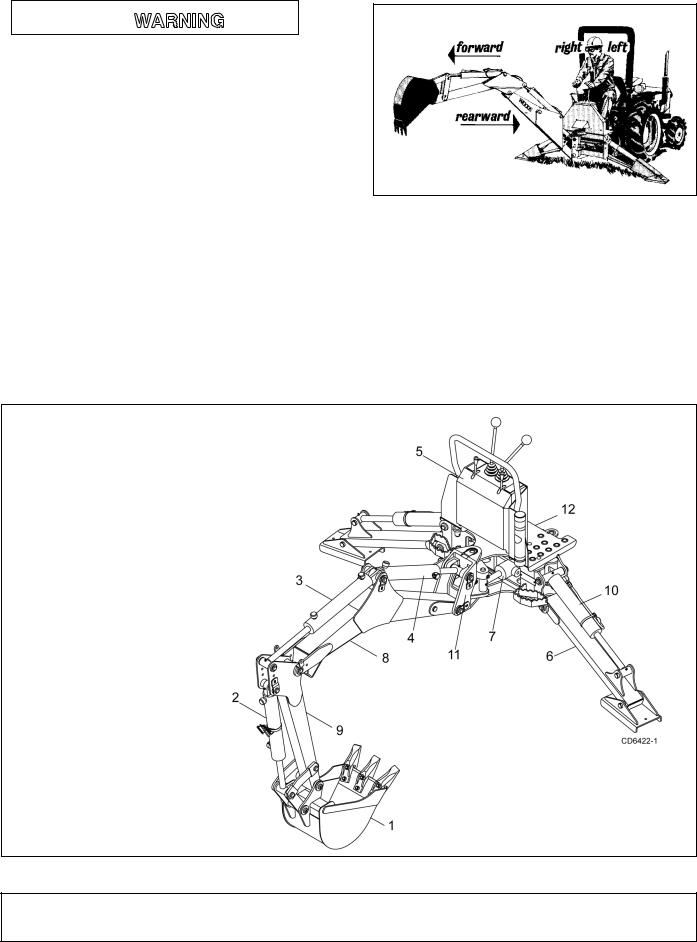
GENERAL INFORMATION

Some illustrations in this manual show the equipment with safety shields removed to provide a better view. This equipment should never be operated with any necessary safety shielding removed.
The purpose of this manual is to assist in setting up, operating and maintaining your backhoe. Read it carefully. It furnishes information and instructions that will help you achieve years of dependable performance.
These instructions have been compiled from extensive field experience and engineering data. Some information may be general in nature due to unknown and varying conditions. However, through experience and these instructions, you should be able to develop procedures suitable to your particular situation.
The illustrations and data used in this manual were current at the time of printing, but due to possible in-line production changes, your machine may vary slightly in detail. We reserve the right to redesign and change the machines, as may be necessary, without notification.
Figure 1. Backhoe Directions
Throughout this manual, references are made to right, left, forward and rearward directions. These are determined from the backhoe operator seat position facing rearward as shown in Figure 1.
Terms for backhoe components have some variations throughout the industry. We use SAE designations as shown in Figure 2.
1.Bucket
2.Bucket cylinder
3.Dipperstick cylinder
4.Boom cylinder
5.Console
6.Stabilizer
7.Swing cylinder
8.Boom
9.Dipperstick
10.Stabilizer cylinder
11.Swing frame
12.Main frame
Figure 2. Backhoe Components
6 Introduction |
MAN0306 (Rev. 5/23/2008) |
|

SAFETY RULES
ATTENTION! BECOME ALERT! YOUR SAFETY IS INVOLVED!
Safety is a primary concern in the design and manufacture of our products. Unfortunately, our efforts to provide safe equipment can be wiped out by an operator’s single careless act.
In addition to the design and configuration of equipment, hazard control and accident prevention are dependent upon the awareness, concern, judgement, and proper training of personnel involved in the operation, transport, maintenance, and storage of equipment.
It has been said, “The best safety device is an informed, careful operator.” We ask you to be that kind of operator.
INSTALLATION
Hydraulics must be connected as instructed in this manual. Do not substitute parts, modify, or connect in any other way.
After connecting hoses, check that all control lever positions function as instructed in the Operator's Manual. Do not put into service until control lever and equipment movements are correct.
TRAINING
Safety instructions are important! Read all attachment and power unit manuals; follow all safety rules and safety decal information. (Replacement manuals and safety decals are available from your dealer. To locate your nearest dealer, check the Dealer Locator at www.woodsonline.com, or in the United States and Canada call 1-800-319-6637.) Failure to follow instructions or safety rules can result in serious injury or death.
If you do not understand any part of this manual and need assistance, see your dealer.
Know your controls and how to stop engine and attachment quickly in an emergency.
Operators must be instructed in and be capable of the safe operation of the equipment, its attachments, and all controls. Do not allow anyone to operate this equipment without proper instructions.
Keep hands and body away from pressurized lines. Use paper or cardboard, not hands or other body parts to check for leaks. Wear safety goggles. Hydraulic fluid under pressure can easily penetrate skin and will cause serious injury or death.
Make sure that all operating and service personnel know that if hydraulic fluid penetrates skin, it must be surgically removed as soon as possible by
a doctor familiar with this form of injury or gangrene, serious injury, or death will result. CONTACT A PHYSICIAN IMMEDIATELY IF FLUID ENTERS SKIN OR EYES. DO NOT DELAY.
Never allow children or untrained persons to operate equipment.
PREPARATION
Check that all hardware is properly installed. Always tighten to torque chart specifications unless instructed otherwise in this manual.
Air in hydraulic systems can cause erratic operation and allows loads or equipment components to drop unexpectedly. When connecting equipment or hoses or performing any hydraulic maintenance, purge any air in hydraulic system by operating all hydraulic functions several times. Do this before putting into service or allowing anyone to approach the equipment.
After connecting hoses, check that all control lever positions function as instructed in the Operator's Manual. Do not put into service until control lever and equipment movements are correct.
Protective hose sleeves must cover all hydraulic hoses within 20 inches of the operator and be secured onto metal hose fittings. Replace hoses or sleeves if damaged or if protective sleeve cannot be properly positioned or secured.
Make sure all hydraulic hoses, fittings, and valves are in good condition and not leaking before starting power unit or using equipment. Check and route hoses carefully to prevent damage. Hoses must not be twisted, bent sharply, kinked, frayed, pinched, or come into contact with any moving parts. Operate moveable components through full operational range to check clearances. Replace any damaged hoses immediately.
Always wear relatively tight and belted clothing to avoid getting caught in moving parts. Wear sturdy, rough-soled work shoes and protective equipment for eyes, hair, hands, hearing, and head; and respirator or filter mask where appropriate.
Make sure attachment is properly secured, adjusted, and in good operating condition.
Power unit must be equipped with ROPS or ROPS cab and seat belt. Keep seat belt securely fastened. Falling off power unit can result in death from being run over or crushed. Keep foldable ROPS system in “locked up” position at all times.
BH6000_SR (Rev. 7/14/2006)
Safety 7

SAFETY RULES
ATTENTION! BECOME ALERT! YOUR SAFETY IS INVOLVED!
Never put backhoe into service unless backhoe manufacturer's sub-frame has been installed and adjusted.
Be sure that backhoe is properly mounted, adjusted, and in good operating condition.
Make sure all safety decals are installed. Replace if damaged. (See Safety Decals section for location.)
Make sure shields and guards are properly installed and in good condition. Replace if damaged.
A minimum 20% of tractor and equipment weight must be on tractor front wheels with backhoe in transport position. Without this weight, tractor could tip over, causing personal injury or death. The weight may be attained with a loader, front wheel weights, ballast in tires, or front tractor weights. When attaining the minimum 20% weight on the front wheels, you must not exceed the Roll Over Protection Structure (ROPS) weight certification. Weigh the tractor and equipment. Do not estimate.
Clean all dirt, trash, and grease from operator's platform and steps.
OPERATION
Do not allow bystanders in the area when operating, attaching, removing, assembling, or servicing equipment.
Before operating, make sure stabilizer pads are lowered firmly to the ground. Stabilizer arms provide support for the backhoe and support for the backhoe mounting brackets.
Consult local utilities before working. Know location of all underground cables, pipelines, overhead wires, and other hazards in working area and avoid contact.
Keep bystanders away from operator, stabilizer, and maximum bucket swing areas.
Do not operate or transport equipment while under the influence of alcohol or drugs.
Operate only in daylight or good artificial light.
Always comply with all state and local lighting and marking requirements.
Do not allow riders. Do not lift or carry anybody on the power unit or attachments.
Power unit must be equipped with ROPS or ROPS cab and seat belt. Keep seat belt securely fastened. Falling off power unit can result in death
from being run over or crushed. Keep foldable ROPS system in “locked up” position at all times.
When operating controls, always sit in backhoe seat.
The only time the backhoe may be operated from a position other than the operator seat is during backhoe attachment and removal. Operator must:
•Read Mounting Kit Manual instructions on attaching and removing backhoe and use extreme care.
•Always stand between rear tire and backhoe stabilizer arms or along side of tractor to avoid being trapped should the boom swing control be accidentally activated.
Always dump spoil at least two feet away from opening.
Use extreme care when working close to fences, ditches, other obstructions, or on hillsides.
Be careful when swinging loaded bucket on a hillside. Always dump spoil on uphill side of backhoe to minimize the possibility of upset.
Never leave equipment unattended with engine running or with bucket in raised position. Always engage swing and boom transport locks, relieve system pressure by operating controls, and remove ignition key before leaving equipment.
Do not use backhoe for craning; it is primarily designed for digging. Mechanical failures such as hose rupture will cause a load to drop suddenly.
TRANSPORTATION
Always engage swing and boom transport locks and attach Slow Moving Vehicle (SMV) sign before transporting backhoe.
Power unit must be equipped with ROPS or ROPS cab and seat belt. Keep seat belt securely fastened. Falling off power unit can result in death from being run over or crushed. Keep foldable ROPS system in “locked up” position at all times.
Never exceed 20 mph (32.2 km/h) during transport.
Always comply with all state and local lighting and marking requirements.
Never allow riders on power unit or attachment.
Do not operate or transport on steep slopes.
Do not operate or transport equipment while under the influence of alcohol or drugs.
8 Safety
BH6000_SR (Rev. 7/14/2006)

SAFETY RULES
ATTENTION! BECOME ALERT! YOUR SAFETY IS INVOLVED!
MAINTENANCE
Do not modify or alter or permit anyone else to modify or alter the equipment or any of its components in any way.
Do not allow bystanders in the area when operating, attaching, removing, assembling, or servicing equipment.
Your dealer can supply original equipment hydraulic accessories and repair parts. Substitute parts may not meet original equipment specifications and may be dangerous.
Adjustment of system relief pressure must be done by a qualified, experienced dealership. Incorrect adjustment can result in system failures and serious personal injury.
Always wear relatively tight and belted clothing to avoid getting caught in moving parts. Wear sturdy, rough-soled work shoes and protective equipment for eyes, hair, hands, hearing, and head; and respirator or filter mask where appropriate.
Dealer service personnel must perform work that requires engine operation during service.
Before working on backhoe, extend boom and dipperstick and place bucket on ground. Make sure
that all system pressure has been relieved by operating controls before performing maintenance or service or before disconnecting any hydraulic lines.
Keep all persons away from operator control area while performing adjustments, service, or maintenance.
Tighten all bolts, nuts, and screws to torque chart specifications. Check that all cotter pins are installed securely to ensure equipment is in a safe condition before putting unit into service.
Make sure all safety decals are installed. Replace if damaged. (See Safety Decals section for location.)
Make sure shields and guards are properly installed and in good condition. Replace if damaged.
STORAGE
Block equipment securely for storage.
Keep children and bystanders away from storage area.
Refer to Removing and Storing Backhoe in Operation section of backhoe manual.
BH6000_SR (Rev. 7/14/2006)
Safety 9
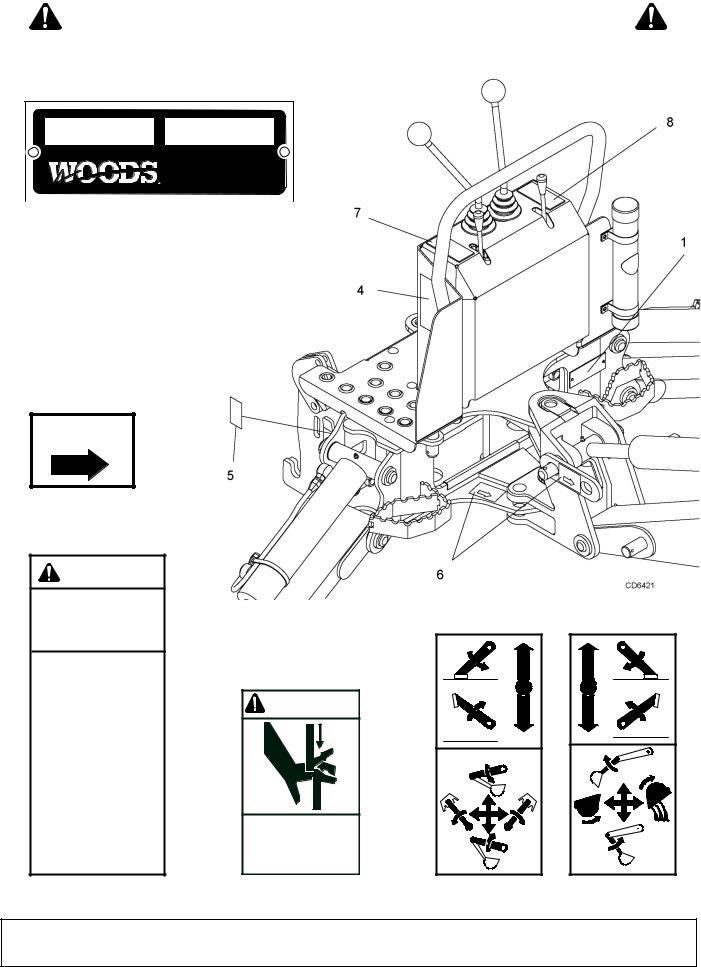
SAFETY & INSTRUCTIONAL DECALS
ATTENTION! BECOME ALERT! YOUR SAFETY IS INVOLVED!
Replace Immediately If Damaged!
1 - SERIAL NUMBER PLATE
MODEL NO. |
SERIAL NO. |
|
Woods Equipment Company |
|
Oregon, Illinois, U.S.A. |
6 - PN 33437
LOCK
33437-E
4 - PN 1008365
|
|
|
8 - PN 37885 |
7 - PN 37884 |
|
HIGH- |
5 - PN 1006885 |
|
|
||
HYDRAULIC |
|
|
|||
CAN PENETRATE SKIN |
WARNING |
|
|
||
AND RESULT IN |
|
|
|||
SEVERE INJURY, |
|
|
|
|
|
GANGRENE OR DEATH. |
|
|
|
|
|
Check for leaks |
|
|
FLOAT |
|
|
with cardboard; |
|
|
|
||
|
|
|
|
||
never use hand. |
|
|
|
|
|
Before you loosen |
|
|
|
|
|
fittings: lower load, |
|
|
|
|
|
release pressure, |
|
|
|
|
|
and be sure oil is |
PINCH POINT |
|
|
||
cool. |
|
|
|||
See a doctor at once if |
Keep hands |
|
|
||
oil enters skin. |
clear. |
1006885 |
37885-A |
37884-A |
|
1008365 |
|||||
|
|||||
10 Safety |
|
|
|
MAN0306 (Rev.5/23/2008) |
|
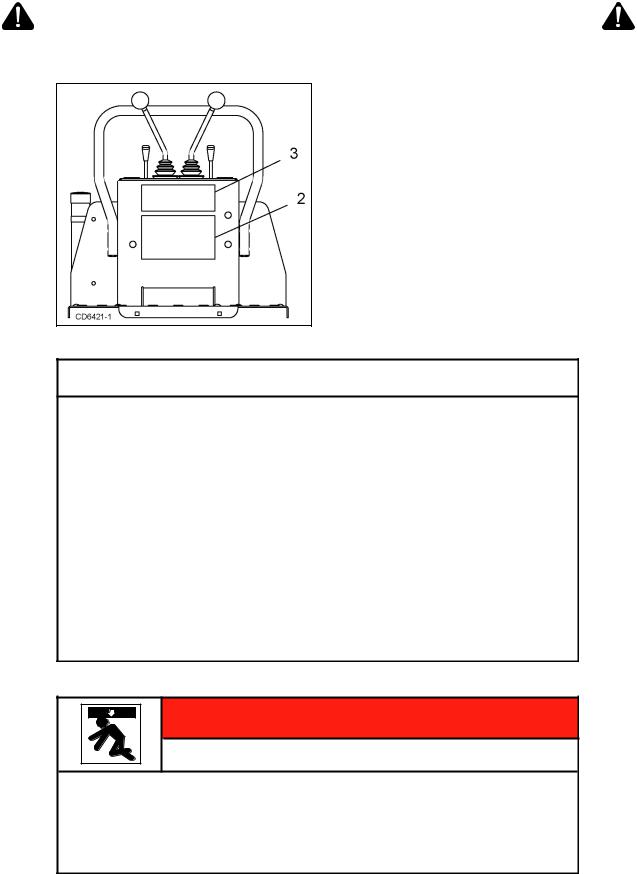
SAFETY & INSTRUCTIONAL DECALS
ATTENTION! BECOME ALERT! YOUR SAFETY IS INVOLVED!
Replace Immediately If Damaged!
"
2 - PN 1008363
 WARNING
WARNING
TO AVOID SEVERE INJURY OR DEATH,
Read Operator's Manual (Obtain from dealer or, in the United States and Canada call
1-800-319-6637) and follow all safety rules.
Make sure all safety decals are installed and readable. Replace if damaged.Make sure shields and guards are properly installed. Replace if damaged.
A minimum 25% of tractor and equipment weight must be on tractor front wheels with backhoe in transport position.
When using backhoe, always sit in backhoe seat; Keep others out of operator, stabilizer, and maximum bucket swing areas.
Backhoe digging forces can lift and turn tractor over. Make sure stabilizer pads are on firm ground and avoid soft or steep banks.
Consult local utilities before digging. Know location of and avoid contact with all underground cables, pipelines, overhead wires and other hazards in digging area.
Never allow riders on tractor or backhoe.
Before transport, attach Slow Moving Vehicle (SMV) sign and engage transport locks.Before leaving equipment unattended, raise boom and install transport locks, relieve
pressure on dipperstick and bucket, shut engine off, and remove key.
1008363
3 - PN 1008364
 DANGER
DANGER
CRUSHING HAZARD
Never use unless backhoe manufacturer's sub-frame has been installed as instructed in Operator's Manual. (Obtain manuals from dealer or, in the United States and Canada call 1-800-319-6637.)
Do not modify or substitute any part of mounting kits or backhoe.
Failure to follow these instructions can result in severe injury or death from backhoe
being thrust upward, forward, or rearward by digging forces.
1008364
MAN0306 (Rev. 5/23/2008) |
Safety 11 |
|
|
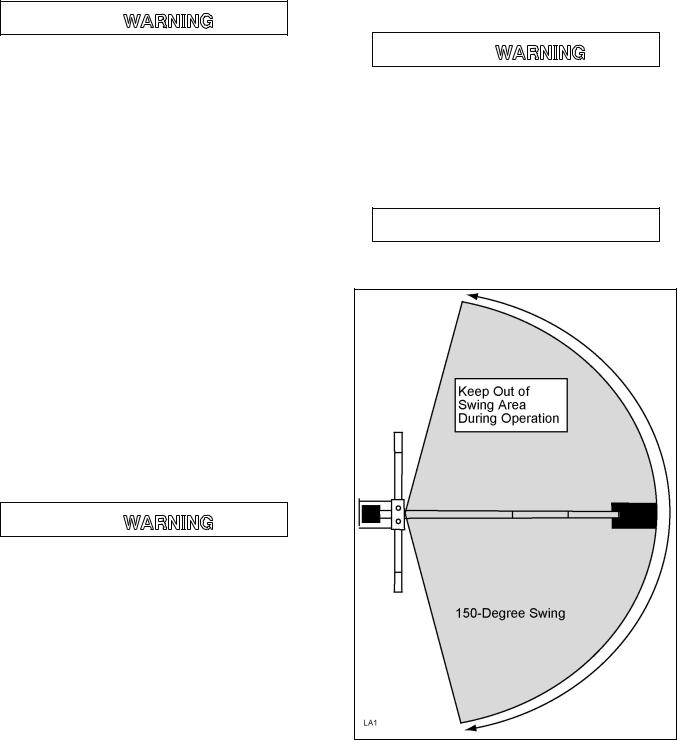
OPERATION
The operator is responsible for the safe operation of the backhoe. The operator must be properly trained. Operators should be familiar with the backhoe, the tractor, and all safety practices before starting operation. Read the safety rules and safety decals on pages 7 to 11.

Make sure all hydraulic hoses, fittings, and valves are in good condition and not leaking before starting power unit or using equipment. Check and route hoses carefully to prevent damage. Hoses must not be twisted, bent sharply, kinked, frayed, pinched, or come into contact with any moving parts. Operate moveable components through full operational range to check clearances. Replace any damaged hoses immediately.
Make sure that all operating and service personnel know that if hydraulic fluid penetrates skin, it must be surgically removed as soon as possible by a doctor familiar with this form of injury or gangrene, serious injury, or death will result. CONTACT A PHYSICIAN IMMEDIATELY IF FLUID ENTERS SKIN OR EYES. DO NOT DELAY.
Before working on backhoe, extend boom and dipperstick and place bucket on ground. Make sure that all system pressure has been relieved by operating controls before maintenance, service, or disconnecting any hydraulic lines.
Keep hands and body away from pressurized lines. Use paper or cardboard, not hands or other body parts to check for leaks. Wear safety goggles. Hydraulic fluid under pressure can easily penetrate skin and will cause serious injury or death.

Consult local utilities before working. Know location of all underground cables, pipelines, overhead wires, and other hazards in working area and avoid contact.
A minimum 20% of tractor and equipment weight must be on tractor front wheels with backhoe in transport position. Without this weight, tractor could tip over, causing personal injury or death. The weight may be attained with a loader, front wheel weights, ballast in tires, or front tractor weights. When attaining the minimum 20% weight on the front wheels, you must not exceed the Roll Over Protection Structure (ROPS) weight certifica-
tion. Weigh the tractor and equipment. Do not estimate.
Never put backhoe into service unless backhoe manufacturer's sub-frame has been installed and adjusted.
OPERATION

Keep bystanders away from operator, stabilizer, and maximum bucket swing areas.
Do not use backhoe for craning; it is primarily designed for digging. Mechanical failures such as hose rupture will cause a load to drop suddenly.
Never allow children or untrained persons to operate equipment.
 CAUTION
CAUTION
When operating controls, always sit in backhoe seat.
Figure 1. Backhoe Swing Area
12 Operation |
MAN0306 (Rev. 5/23/2008) |
|
|
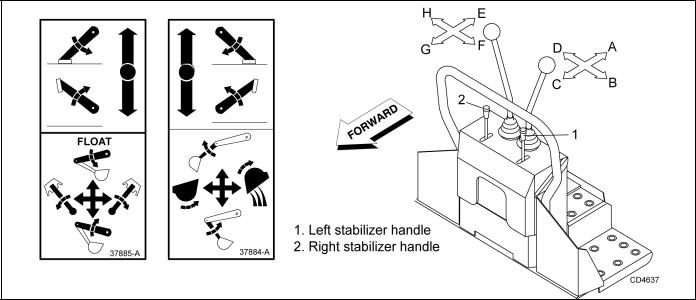
Mechanical failures such as a hose rupture will cause a load to drop. Lifting a heavy load with the dipperstick, then operating the boom, could cause boom to drop. In either case, if anyone is in the operating area (maximum reach of bucket) as shown in Figure 1, serious injury or death could occur.
Do not dig with backhoe unless stabilizers are down and on a firm surface. Stay clear of steep areas or excavation banks that are soft or could give way.
POSITION THE MACHINE
Before operating in an unfamiliar area, walk around the full length of the proposed site and check for hidden holes, drop-off or obstacles that could cause an accident.
Lower stabilizers until they carry the weight of the backhoe. If tractor is equipped with a front loader, place the bucket flat on the ground. Lower loader lift arms until weight is removed from front tractor tires.
Level the machine using stabilizers and front loader before starting to dig.
Stability is very important when operating backhoe in the extreme swing positions as this causes weight transfer.
CONTROL HANDLE OPERATION
Refer to Figure 2.
Assume your position in the operator's seat.
When becoming familiar with backhoe controls, start with a lower rpm.
Set tractor RPM to a speed that moves the backhoe at a rate that you are comfortable with.
Before operating, perform a functional test by placing control handles in their various positions and making certain correct operation occurs, matching decals on operator's console. Pay specific attention to float position of boom. Do not operate backhoe if functions differ from decal; serious injury or death could occur.
It is not difficult to become a successful operator. Control lever operating decals (shown in Figure 2) are next to the operating control levers. Study these decals; they will assist you in becoming familiar with the controls.
Pushing handle 1 forward will lower left stabilizer; pulling back raises it.
Pushing handle 2 forward will lower right stabilizer; pulling back raises it.
Pulling left control back (toward A) raises boom; pushing it forward (toward C) lowers it. Full forward (toward C) is the float position.
Moving left handle left (toward B) swings boom left; moving it right (toward D) swings boom right.
Pulling right control back (toward E) moves dipperstick down and toward operator; pushing it forward (toward G) moves it up and away from operator.
Moving right handle left (toward F) curls bucket toward operator; moving it right (toward H) extends bucket out away from operator.
Operate the control levers, swinging the boom several times to practice control. Do not operate the swing more than 45 degrees each way the first few times. Gradually increase arc.
Figure 2. Operator’s Controls
MAN0306 (Rev. 5/23/2008) |
Operation 13 |
|
|
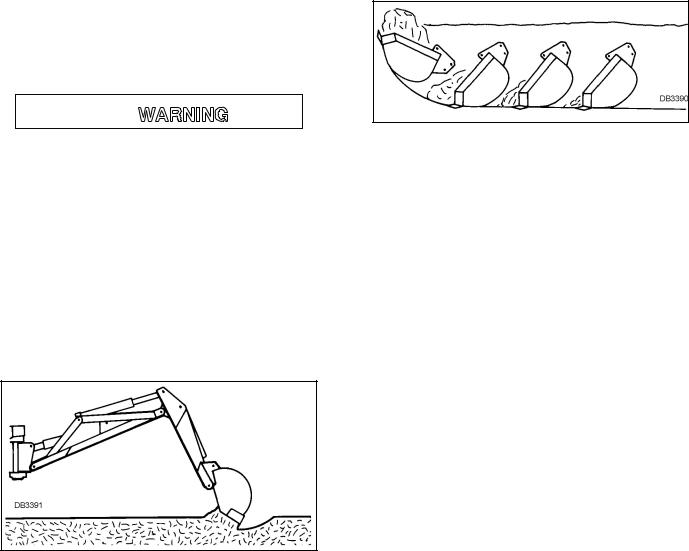
After becoming familiar with the backhoe operation, practice coordinated use of the controls in a safe open area at reduced engine speed. Gradually increase engine speed as the technique is mastered.
Operate backhoe gently and smoothly. Avoid swinging boom into mainframe. Sudden stopping or jerking could result in serious damage to tractor and backhoe.
Strive to develop a smooth digging cycle. Avoid abrupt or jerky movements. This is accomplished by operating two or more controls at the same time and not allowing the cylinders to reach the limit of travel.
Should you become confused during operation, simply let go of the controls. The valve control handles will automatically return to neutral.
START EXCAVATION

Consult local utilities before working. Know location of all underground cables, pipelines, overhead wires, and other hazards in working area and avoid contact.
To start the excavation, position backhoe as shown for maximum breakout force.
Actuate the dipperstick cylinder to start digging. Approximately halfway through digging cycle, start bucket curl while continuing to crowd dipperstick in. Should bucket stall, raise boom slightly.
Do not use down pressure on the boom when starting to dig, as this will lift the machine and move it out of alignment with the work.
Figure 3. Starting Position
FILL BUCKET
Control bucket attitude throughout digging cycle to keep teeth parallel to bottom of excavation. This will provide best penetration angle and minimize dragging and scraping bucket through the ground.
Penetration depth is determined by soil condition and type.
Only use dipperstick and bucket during the digging cycle. As the dipperstick moves the bucket through the soil, curl bucket to maintain proper bucket position.
At the end of the pass, or when bucket is full, curl bucket completely, lift bucket from excavation and swing boom to dump site.
To obtain a cleaner trench and avoid material buildup directly in front of backhoe, extend dipperstick and curl bucket completely while starting to lift it out of the excavation. This will allow excess material to fall back into the excavation.
Figure 4. Fill Bucket
DUMP AND RETURN CYCLE
Keep the swing-dump-return cycle as brief as possible. Keep dipperstick moving outward and start boom swing as soon as the bucket clears the excavation. Continue extending dipperstick and, as you approach the spoil pile, start to dump bucket.
When bucket is empty, dipperstick and bucket are in position to resume digging upon return to the excavation.
TRENCHING AND EXCAVATING
Refer to Figure 5.
Trenching is the most basic backhoe digging operation. Other operations are variations of this basic function.
To maintain a level trench bottom, set bucket at proper approach angle and while crowding dipper-stick in, continually move bucket curl lever to maintain correct cutting angle. At the same time, place boom control in the full forward (float) position and keep the bucket in the same plane.
When handle is placed in the float position, pressure on both sides of boom cylinder is released.
Digging near center of swing so material may be dumped on either side will produce good results. Never dig near stabilizers.
Continue the trench by moving machine along trench centerline away from existing excavation. Move machine approximately one-half the effective backhoe reach. Moving too far will require excessive down pressure for digging and hand clean-up of trench bottom.
14 Operation |
MAN0306 (Rev. 5/23/2008) |
|
|
